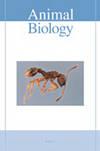Molecular characterization of the ACSS2 gene involved in adaptation to hypoxia in high-altitude cattle breeds
IF 0.9
4区 生物学
Q2 ZOOLOGY
引用次数: 2
Abstract
Under extreme environmental conditions such as hypoxia, insufficient nutrition, and glucose deficiency, the acetyl-CoA synthetase 2 (ACSS2)-mediated acetyl-CoA synthesis pathway plays an alternative role to ensure the normal operation of metabolic activities. To investigate the potential effect of the ACSS2 gene on hypoxic adaptation and its regulatory mechanism of gene expression in high-altitude cattle breeds, we analyzed the genetic variations of the ACSS2 gene in five Bos taurus taurus, Bos taurus indicus, hybrid Bos taurus taurus × Bos taurus indicus Chinese cattle breeds, and two Bos grunniens (yak) breeds distributed at different altitudes (95-3850 m). A total of 58 SNPs was detected in seven populations, and abundant genetic variation was found in high-altitude breeds. We identified the bovine ACSS2 core promoter region between g.-682 and g.-264 by using the luciferase assay in FFB and HepG2 cells. We also identified that the high-altitude hypoxia-specific haplotype (CAGTCT) was composed of six highly linked SNPs. The tagSNP g.-473 T>C (rs23) is located in the core promoter of ACSS2 in the Bos taurus taurus and yak breeds. The recombinant plasmid containing rs23 and analyses of luciferase activity of different genotypes showed that the activity of ACSS2 promoter increased significantly when T was mutated to C. We also found a yak-specific SNP rs20 that consists of 12 base insertions (g.-562 ins GAAAGGACCCTA) in the promoter of yak breeds. Luciferase activity analysis showed that the insertion mutant significantly decreased the promoter activity of ACSS2. Hence, ACSS2 may play an important role in the adaptation to high-altitude hypoxia by generating adaptive alleles to influence gene transcription in cattle. These results signify that different genetic variants and haplotypes affect the activity of the core promoter to regulate ACSS2 gene expression and subsequently overcome and adapt to a high-altitude environment within different cattle breeds. Our findings may have important implications for understanding the mechanism of adaptation to high altitude and for application of molecular breeding in Bos species.高海拔牛品种缺氧适应ACSS2基因的分子特征
在缺氧、营养不足和葡萄糖缺乏等极端环境条件下,乙酰辅酶A合成酶2(ACSS2)介导的乙酰辅酶A合成途径发挥着替代作用,以确保代谢活动的正常运行。为了研究ACSS2基因对高海拔牛种缺氧适应的潜在影响及其基因表达的调控机制,我们分析了ACSS2基因在五个牛牛、印度牛牛、杂交牛牛×印度牛牛中的遗传变异,和分布在不同海拔(95-3850m)的两个牦牛品种。在7个种群中共检测到58个SNPs,在高海拔品种中发现了丰富的遗传变异。我们通过在FFB和HepG2细胞中使用荧光素酶测定法鉴定了牛ACSS2核心启动子区在g-682和g-264之间。我们还发现高海拔缺氧特异性单倍型(CAGTCT)由六个高度连锁的SNPs组成。tagSNP g.-473T>C(rs23)位于牛牛和牦牛品种ACSS2的核心启动子中。含有rs23的重组质粒和对不同基因型萤光素酶活性的分析表明,当T突变为C时,ACSS2启动子的活性显著增加。我们还在牦牛品种的启动子中发现了一个由12个碱基插入(g.-562-ins GAAAGGACCCTA)组成的牦牛特异性SNP rs20。萤光素酶活性分析表明,插入突变体显著降低了ACSS2的启动子活性。因此,ACSS2可能通过产生适应性等位基因来影响牛的基因转录,从而在适应高海拔缺氧中发挥重要作用。这些结果表明,不同的遗传变异和单倍型影响核心启动子的活性,以调节ACSS2基因表达,并随后克服和适应不同牛品种的高海拔环境。我们的发现可能对理解高海拔适应机制和分子育种在Bos物种中的应用具有重要意义。
本文章由计算机程序翻译,如有差异,请以英文原文为准。
求助全文
约1分钟内获得全文
求助全文
来源期刊

Animal Biology
生物-动物学
CiteScore
2.10
自引率
0.00%
发文量
34
审稿时长
3 months
期刊介绍:
Animal Biology publishes high quality papers and focuses on integration of the various disciplines within the broad field of zoology. These disciplines include behaviour, developmental biology, ecology, endocrinology, evolutionary biology, genomics, morphology, neurobiology, physiology, systematics and theoretical biology. Purely descriptive papers will not be considered for publication.
Animal Biology is the official journal of the Royal Dutch Zoological Society since its foundation in 1872. The journal was initially called Archives Néerlandaises de Zoologie, which was changed in 1952 to Netherlands Journal of Zoology, the current name was established in 2003.
 求助内容:
求助内容: 应助结果提醒方式:
应助结果提醒方式:


